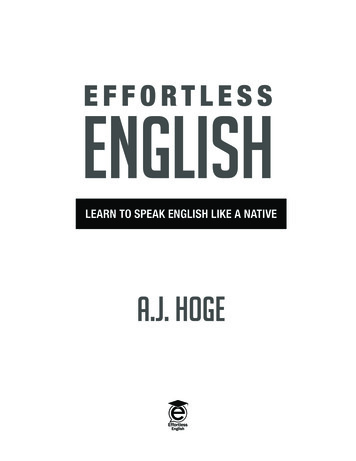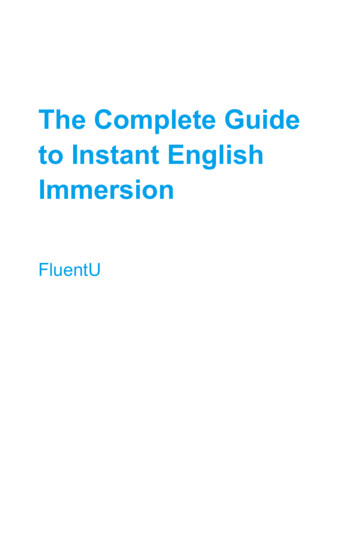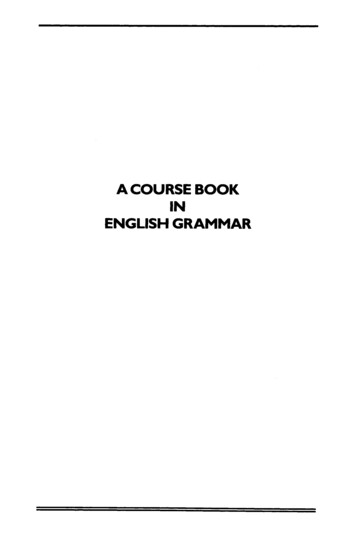
Transcription
Pre-AP* and AP* English Resource GuidesTeach literature while you tackle the tests!Applied Practice integrated test preparation allows teachers to simultaneously preparestudents for their AP exams while remaining immersed in the literature selected for theirAP coursework. Continuous preparation with Applied Practice materials throughouttheir middle and high school years give students the confidence to tackle AP exams.Even better, it integrates seamlessly into teachers’ daily lesson plans.What do you mean by “integrated” test preparation?We offer over 100 Pre-AP* and AP* English resource guides, each utilizing content froma specific fiction or nonfiction book typically taught in Pre-AP or AP English, or contentselected from literary works within a specific genre, such as poetry, nonfiction, essays,speeches, or short stories.Each resource guide consists of 12 multiple-choice practices (9-10 in genre-based guides)6 free-response questions (6-10 in genre-based guides)Answer keys with detailed answer explanationsSuggested teaching strategiesLiterary terms listVocabulary lists by chapter or selectionFree-response Scoring GuideMiddle School and High School CurriculumEach resource guide targets the skills most appropriate to the difficulty of the readingselections included in the guide. For titles commonly read by middle schoolers,multiple-choice questions have been modified slightly to include just four answerchoices, rather than the five choices offered in high school titles.New titles are continually added to our catalog. Visit appliedpractice.com to requestnew product titles!Going paperless?Online delivery of Pre-AP* and AP* practices will be available this fall with APO Pro.Visit www.appliedpractice.com/applied-practice-online for details.3519 Cedar Springs Rd, Ste ADallas, TX 75219www.appliedpractice.comph 866.374.3768fax 866.897.6137
These sample pages are extracted from a resource guide revised in 2016to more accurately represent the current question types students encounter on theAP Language and AP Literature & Composition exams.APPLIED PRACTICEResource GuideA Separate PeacePre-AP*/AP* VersionTeacher NotesA Note for Teachers. 5A Note about Format . 7Teaching ResourcesStrategies for Multiple-Choice Questions. 11Strategies for Free-Response Questions . 12Glossary of Literary Terms. 13Vocabulary Lists by Passage . 21Student PracticesMultiple-Choice Questions . 27Free-Response Questions. 53Answer Key and ExplanationsMultiple-Choice Answer Key . 63Multiple-Choice Answer Explanations. 67Free-Response Scoring Guide. 83*Pre-AP and AP are registered trademarks of the College Entrance Examination Board, which was not involved in the production of,and does not endorse, this product. 2016 by Applied Practice, Ltd., Dallas, TX. All rights reserved.Licensed for one classroom only. May not be shared or reproduced for use by multiple teachers.
These sample pages are extracted from a resource guide revised in 2016to more accurately represent the current question types students encounter on theAP Language and AP Literature & Composition exams.GLOSSARY OF LITERARY TERMSabsolute—a word free from limitations or qualifications (“best,” “all,” “unique,”“perfect”)adage—a familiar proverb or wise sayingad hominem argument—an argument attacking an individual’s character rather than hisor her position on an issueallegory—a literary work in which characters, objects, or actions represent abstractionsalliteration—the repetition of initial sounds in successive or neighboring wordsallusion—a reference to something literary, mythological, or historical that the authorassumes the reader will recognizeanalogy—a comparison of two different things that are similar in some wayanaphora—the repetition of words or phrases at the beginning of consecutive lines orsentencesanecdote—a brief narrative that focuses on a particular incident or eventantecedent—the word, phrase, or clause to which a pronoun refersantithesis—a statement in which two opposing ideas are balancedaphorism—a concise statement that expresses succinctly a general truth or idea, oftenusing rhyme or balanceapostrophe—a figure of speech in which one directly addresses an absent or imaginaryperson, or some abstractionarchetype—a detail, image, or character type that occurs frequently in literature andmyth and is thought to appeal in a universal way to the unconscious and to evokea responseargument—a statement of the meaning or main point of a literary workasyndeton—a construction in which elements are presented in a series withoutconjunctions 2016 by Applied Practice, Ltd., Dallas, TX. All rights reserved.Licensed for one classroom only. May not be shared or reproduced for use by multiple teachers.
These sample pages are extracted from a resource guide revised in 2016to more accurately represent the current question types students encounter on theAP Language and AP Literature & Composition exams.VOCABULARY LIST FOR A SEPARATE PEACENote: Vocabulary from the literary passage is listed first, followed by vocabulary fromthe questions and answers.Passage 1Passage 2Passage emptuousintrospective 2016 by Applied Practice, Ltd., Dallas, TX. All rights reserved.Licensed for one classroom only. May not be shared or reproduced for use by multiple teachers.
These sample pages are extracted from a resource guide revised in 2016to more accurately represent the current question types students encounter on theAP Language and AP Literature & Composition exams.Directions: This part consists of selections from A Separate Peace and questions on their content, form, andstyle. After reading a passage, choose the best answer to each question.Note: Pay particular attention to the requirement of questions that contain the words NOT, LEAST, orEXCEPT.Passage 1, Questions 1-8. Read the passage from Chapter 1 which begins “The tree was tremendous” andends “‘The tree is waiting’” (pages 6-9) carefully before you choose your answers.1.In the first paragraph, the word that, because of its connotations, seems not to fit the overall tone is(A)(B)(C)(D)(E)2.The comparison of Phineas’ voice to a hypnotist’s eyes serves primarily to(A)(B)(C)(D)(E)3.the narrator has a sardonic sense of humorPhineas understands Gene quite wellFinny enjoys scaring GeneGene is from New EnglandFinny is mocking GeneWhich of the following pairs most dramatically illustrates the great gulf between the narrator’s agegroup and the seniors?(A)(B)(C)(D)(E)5.suggest his influence over the other boyscreate a surreal effect by combining two sensesemphasize the narrator’s careful attention to detailindicate that his voice is unusually soothingimply that his voice is more expressive than his eyesFrom the paragraph beginning “‘Aey-uh,’ he said,” it can be inferred �steeple”“irate”“crazy”“Lower Middler” and “Upper Middler”“groveling status” and “near respectability”“numbly reading Virgil” and “accelerated courses“playing tag” and “draft-bait”“seventeen year old bunch” and “a year’s advantage”The tone of Finny’s statement “here’s my contribution to the war effort” could best be described contemplative 2016 by Applied Practice, Ltd., Dallas, TX. All rights reserved.Licensed for one classroom only. May not be shared or reproduced for use by multiple teachers.
These sample pages are extracted from a resource guide revised in 2016to more accurately represent the current question types students encounter on theAP Language and AP Literature & Composition exams.6.In the first half of the paragraph beginning “I was,” the narrator conveys what he was experiencingprimarily by(A)(B)(C)(D)(E)7.After the jump, the narrator most likely says “I felt fine” because he(A)(B)(C)(D)(E)8.relating his thoughts as he approached the treefocusing on the appearance and feel of the treedescribing his own physical sensationscomparing his climb to a wartime maneuveremphasizing his young age at the time of the eventswas not injuredwas no longer afraidwas braver than Finnywas proud of himselfwas still aliveFrom this passage, the narrator could best be described as(A)(B)(C)(D)(E)maniacal and impulsivepedantic and objectivecondescending yet practicalanalytical and introspectivefawning and lighthearted 2016 by Applied Practice, Ltd., Dallas, TX. All rights reserved.Licensed for one classroom only. May not be shared or reproduced for use by multiple teachers.
These sample pages are extracted from a resource guide revised in 2016to more accurately represent the current question types students encounter on theAP Language and AP Literature & Composition exams.Question 1(Suggested time–40 minutes)Read the passage in Chapter 1 which begins “‘You boys look fine . . .’” and ends “‘And we’re going to fightit’” (pages 19 - ). In a well-organized essay, discuss the differences in opinion of the boys and Mr. Hadleyabout serving in the war, and explain the rhetorical strategies the author uses to convey his support for one sideor the other. 2016 by Applied Practice, Ltd., Dallas, TX. All rights reserved.Licensed for one classroom only. May not be shared or reproduced for use by multiple teachers.
Applied Practice resource guides for AP* Englishare also available for these literary selections:American Essays Selections, Vol 1American Speeches SelectionsContemporary Nonfiction SelectionsContemporary Poetry SelectionsAmerican Short Stories SelectionsMastering SynthesisAmerican Essays Selections, Vol 2World Speeches SelectionsNonfiction SelectionsPoetry SelectionsSatire SelectionsMastering Nonfiction with DocumentationFiction and Nonfiction Titles1984 Jane EyreAcross Five Aprils Julius CaesarAdventures of Huckleberry Finn The Kite RunnerThe Adventures of Tom Sawyer Life of PiAll the Pretty Horses Lord of the FliesAngela’s Ashes MacbethAnimal Dreams The Mayor of CasterbridgeAnimal Farm MetamorphosisAs I Lay Dying A Midsummer Night’s DreamThe Awakening The Miracle WorkerBeloved Moby DickBeowulf Much Ado About NothingBless Me, Ultima The Narrative of the Life of Frederick DouglassBrave New World NightSelections from The Canterbury Tales The OdysseyThe Call of the Wild The Oedipus TrilogyThe Catcher in the Rye Of Mice and MenThe Count of Monte Cristo OthelloCrime and Punishment The OutsidersThe Crucible The PearlCry, the Beloved Country The Picture of Dorian GrayDeath of a Salesman The Poisonwood BibleThe Diary of Anne Frank A Portrait of the Artist as a Young ManEast of Eden Pride and PrejudiceEthan Frome Pygmalion and Major BarbaraFahrenheit 451 Roll of Thunder, Hear My CryA Farewell to Arms Romeo and JulietFrankenstein The Scarlet LetterThe Giver The Secret Life of BeesThe Glass Menagerie A Separate PeaceThe Grapes of Wrath Something Wicked This Way ComesGreat Expectations The StrangerThe Great Gatsby A Streetcar Named DesireGulliver’s Travels A Tale of Two CitiesHamlet Tess of the d’UrbervillesHeart of Darkness Their Eyes Were Watching GodThe Hobbit Things Fall ApartHoles The Things They CarriedThe House on Mango Street To Kill a MockingbirdThe Iliad Twelfth NightThe Importance of Being Earnest WaldenIn Cold Blood The Watsons Go to BirminghamThe Inferno Where the Red Fern GrowsInvisible Man Wuthering HeightsFor a complete list including new titles and other Applied Practice curriculum,visit www.appliedpractice.com
6 free-response questions (6-10 in genre-based guides) . Read the passage from Chapter 1 which begins “The tree was tremendous” and ends “‘The tree is waiting’” (pages 6-9) carefully before you choose your answers. . Bless Me, Ultima The Narrativ











